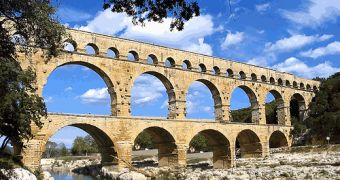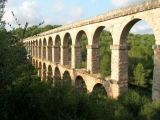They had central heating, baths with all the commodities and bridges and roads that are still functional even after two millennia. The Colosseum could have resisted in perfect state if it had not been plundered. All was made of stone, timber and concrete. From Iraq to Portugal and from Sahara to Romania, Germany and UK, the Romans still impress us with their buildings of cement, stone and bricks. The Romans' greatest discovery was the concrete.
One of the most impressive pieces of Roman architecture were the aqueducts. In Spain, Roman aqueducts were still used during the 19th century. Medieval Arabs copied the Roman architecture of the aqueducts.
Roman aqueducts brought water into the ancient cities. But their role went even further, as a symbol of Roman engineering, an item of standing, social prestige and luxury. Not the aqueduct made the city, but the city could afford an aqueduct. The reasons for making the aqueducts were the same that made the cities build forums, thermal baths, amphitheaters and circuses. An aqueduct was a reason of proud for the city dwellers.
Still, the Roman aqueducts represent a formidable technological progress. The inhabitants of the Roman cities had at their disposal a daily water amount 10 to 20 times bigger than the city dwellers of the Europe of the 19th century, who consumed about 25-50 liters of water each day.
During the Rome of the emperor Trajan (98-117 AD), each inhabitant of Rome could use, at least theoretically, 1,000 liters of water daily, which is twice more than a French inhabitant in 1987! And Rome was not the only example: four aqueducts could deliver to Lyon 80,000 cubic meters of water daily, while just one aqueduct delivered 37,400 cubic meters of water each day to a neighboring city. All this water served both for public and individual needs.
In Pompeii, few particulars installed current water in the house. Instead, plenty of water flowed in the public wells, draining from the streets into a sewage system that ensured cleanliness of the city.

 14 DAY TRIAL //
14 DAY TRIAL // 
